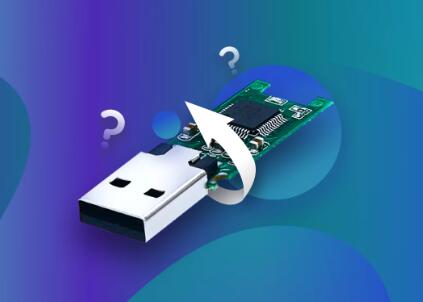USB flash drives have become indispensable for data storage and transfer, offering portability, convenience, and reasonable storage capacity. However, their frequent usage and physical nature make them vulnerable to damage. Whether it’s due to physical impact, electrical failure, file system corruption, or improper ejection, a damaged USB flash drive can result in the loss of important documents, photos, videos, and other files.
Physical Damage: Includes broken connectors, cracked casing, water damage, or internal circuit board failures.
Logical Damage: Caused by file system corruption, accidental formatting, malware infection, or improper ejection.

Electrical Damage: Results from power surges, faulty USB ports, or electrostatic discharge.
Each type of damage requires a different approach to recovery, and recognizing the nature of the problem can help you choose the appropriate method.
Initial Steps to Take
Stop Using the Drive Immediately: Continuing to use a damaged USB flash drive can cause further data loss or overwrite existing files, making recovery more difficult.
Inspect for Physical Damage: Check the drive for visible signs of physical damage. Avoid inserting a physically damaged USB into any port as it may cause harm to your computer or the device itself.
Try a Different USB Port or Computer: Sometimes, the issue might not be with the USB drive but with the port or the system. Try connecting the flash drive to a different USB port or another computer.
Use Disk Management Tools: On Windows, you can use Disk Management to see if the drive is detected. On macOS, Disk Utility can provide similar insights.
Recovery Methods for Logical Damage
Logical damage is one of the most common issues and can often be resolved using software tools. Here are some effective methods:
Method 1: Use Command Prompt (Windows)
If your USB is recognized but the files are inaccessible, the Command Prompt can help recover files.
Connect the USB flash drive.
Open Command Prompt as Administrator.
Type chkdsk X: /f (replace X with the drive letter).
Wait for the system to scan and fix file system errors.
This process can often restore access to corrupted or hidden files.
Method 2: Use Built-in Recovery Tools
Windows File Recovery Tool: A command-line tool provided by Microsoft to recover lost files.
macOS Terminal: Use diskutil list to locate and attempt repairs.
Method 3: Use Third-Party Data Recovery Software
Panda Assistant: Specialized software that can recover data from physically and logically damaged USB drives.
Steps to Use Data Recovery Software:
Install the software on your computer.
Insert the USB drive.
Launch the software and select the USB drive.
Perform a quick or deep scan.
Preview and recover the desired files to a different location.
Recovery Methods for Physical Damage
Recovering data from physically damaged USB flash drives is more challenging and may require professional help. However, some DIY steps can be attempted:
Method 1: Repairing the USB Connector
If the USB connector is broken but the circuit board is intact:
Carefully open the USB casing.
Use a soldering iron to reattach the connector.
Connect the repaired USB to the computer.
Method 2: USB Adapter or Enclosure
Sometimes, the USB interface is the issue. Try using a USB adapter or enclosure that fits the internal memory chip.
Method 3: Chip-Off Recovery (Advanced)
This involves removing the NAND memory chip and reading it using specialized hardware. It’s a complex process and best handled by data recovery professionals.
Preventing Future Data Loss
To avoid similar issues in the future, consider these preventive measures:
Always Eject USB Drives Properly: Use the “Safely Remove Hardware” option before unplugging.
Avoid Physical Stress: Handle USB drives gently and avoid dropping or crushing them.
Use Surge Protectors: Protect your devices from electrical damage.
Regular Backups: Store important files in multiple locations, including cloud storage and external hard drives.
Keep Antivirus Software Updated: Prevent malware that could corrupt USB file systems.
When to Seek Professional Help
If your USB flash drive has suffered severe physical damage or recovery software fails to detect it, consult a professional data recovery service. These experts have the tools and cleanroom environments necessary for delicate recoveries.
Some reputable services include:
DriveSavers
Ontrack
Secure Data Recovery
Gillware
They offer diagnostic evaluations and often operate on a “no data, no charge” basis.
Recovering files from a damaged USB flash drive may seem daunting, but with the right approach and tools, it is often possible to retrieve your valuable data. Start by identifying the type of damage and use the appropriate recovery method whether it’s a simple command-line fix or advanced recovery software like Panda Assistant. For physically damaged drives, DIY repairs should be attempted with caution, and professional help may be the best option. By following best practices and taking preventative steps, you can protect your data and reduce the risk of future losses.
About us and this blog
Panda Assistant is built on the latest data recovery algorithms, ensuring that no file is too damaged, too lost, or too corrupted to be recovered.
Request a free quote
We believe that data recovery shouldn’t be a daunting task. That’s why we’ve designed Panda Assistant to be as easy to use as it is powerful. With a few clicks, you can initiate a scan, preview recoverable files, and restore your data all within a matter of minutes.

 Try lt Free
Try lt Free Recovery success rate of up to
Recovery success rate of up to









